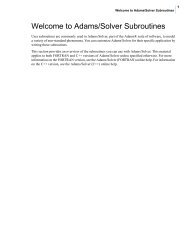You also want an ePaper? Increase the reach of your titles
YUMPU automatically turns print PDFs into web optimized ePapers that Google loves.
Creating <strong>Virtual</strong> <strong>Machine</strong> Models with Quest<br />
Adding Kinematics to the Model<br />
The MHERML50 model, for an example, defines a machine with a C-axis rotary table, mounted<br />
on an A-axis trunnion table, mounted on the machine base. The Z-axis column is mounted on an<br />
X-axis rail, in turn mounted on a Y-axis gantry. For the head assembly, the Y-axis is connected<br />
closest to the machine origin. Moving the Y-axis causes the X and Z axes to move, along with<br />
the tool. Moving the Z-axis leaves the X and Y axes unchanged. This machine model also<br />
defines a number of other axes, which do interesting things like control the doors and position<br />
the operator‟s pendant. These additional axes follow the same rules.<br />
The following axes types can be created using the Simulation»Construct Axis menu bar selection<br />
(and also from the buttons on the VM Construct toolbar shown circled above):<br />
� Linear defines X, Y and Z axes slides<br />
� Rotary defines A, B and C axes tables and heads<br />
� Curve defines axes which move along a profile<br />
� Tool defines where tools are mounted<br />
� Stock defines where fixtures and parts are mounted<br />
� Head defines where removable head attachments are mounted<br />
� A Reference axis doesn‟t control motion; it is used to group related components<br />
All axes share some common parameters (a description<br />
of all axes parameters can be found starting on<br />
page 96).<br />
An axis Name should be a short meaningful string.<br />
The name is used in the lower right “Axes” window<br />
and in the Model Navigator to identify the axis.<br />
The Unit selection by default will match the model<br />
units. This defined the units of measure for position<br />
and range information.<br />
The Position of an axis defines where its origin is, in<br />
respect to the object to which the axis is attached.<br />
Axes attached to the base machine are defined in<br />
relation to the grid origin. The Direction of an axis<br />
can be along one of the major axes. Typically, axes that move the part have a reversed sign and<br />
those that move the tool have a normal sign. You can enter a “Custom” orientation, by giving the<br />
axis‟ XYZ components of positive motion. The Range of an axis defines the limits of its motion.<br />
The Default position specifies the axis setting when the model is opened.<br />
You can Slave one axis to another by selecting a parent axis in the drop-down choice list. When<br />
an axis is slaved, its position is controlled by the parent axis‟ position, multiplied by the signed<br />
Scaling factor. A slaved axis will not have its own slider control in the lower right “Axes”<br />
window; a slaved axis can only be moved by moving its parent axis.<br />
<strong>ICAM</strong> Technologies Corporation – Proprietary 43















